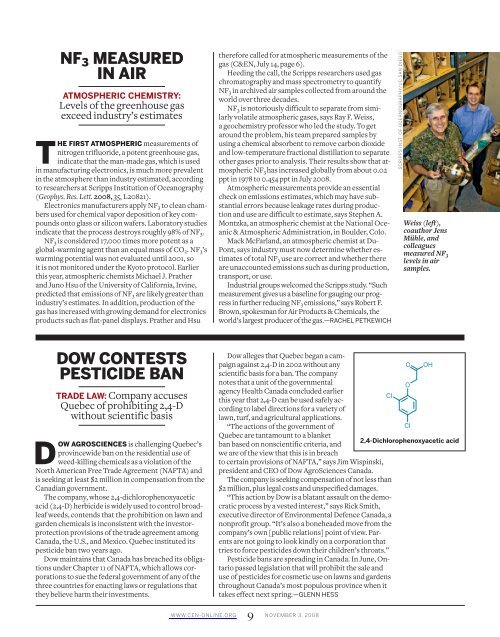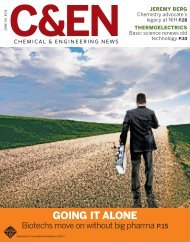Chemical & Engineering News Digital Edition ... - IMM@BUCT
Chemical & Engineering News Digital Edition ... - IMM@BUCT
Chemical & Engineering News Digital Edition ... - IMM@BUCT
Create successful ePaper yourself
Turn your PDF publications into a flip-book with our unique Google optimized e-Paper software.
NF 3 MEASURED<br />
IN AIR<br />
ATMOSPHERIC CHEMISTRY:<br />
Levels of the greenhouse gas<br />
exceed industry’s estimates<br />
THE FIRST ATMOSPHERIC measurements of<br />
nitrogen trifluoride, a potent greenhouse gas,<br />
indicate that the man-made gas, which is used<br />
in manufacturing electronics, is much more prevalent<br />
in the atmosphere than industry estimated, according<br />
to researchers at Scripps Institution of Oceanography<br />
(Geophys. Res. Lett. 2008, 35, L20821).<br />
Electronics manufacturers apply NF 3 to clean chambers<br />
used for chemical vapor deposition of key compounds<br />
onto glass or silicon wafers. Laboratory studies<br />
indicate that the process destroys roughly 98% of NF 3 .<br />
NF 3 is considered 17,000 times more potent as a<br />
global-warming agent than an equal mass of CO 2 . NF 3 ’s<br />
warming potential was not evaluated until 2001, so<br />
it is not monitored under the Kyoto protocol. Earlier<br />
this year, atmospheric chemists Michael J. Prather<br />
and Juno Hsu of the University of California, Irvine,<br />
predicted that emissions of NF 3 are likely greater than<br />
industry’s estimates. In addition, production of the<br />
gas has increased with growing demand for electronics<br />
products such as flat-panel displays. Prather and Hsu<br />
therefore called for atmospheric measurements of the<br />
gas (C&EN, July 14, page 6).<br />
Heeding the call, the Scripps researchers used gas<br />
chromatography and mass spectrometry to quantify<br />
NF 3 in archived air samples collected from around the<br />
world over three decades.<br />
NF 3 is notoriously difficult to separate from similarly<br />
volatile atmospheric gases, says Ray F. Weiss,<br />
a geochemistry professor who led the study. To get<br />
around the problem, his team prepared samples by<br />
using a chemical absorbent to remove carbon dioxide<br />
and low-temperature fractional distillation to separate<br />
other gases prior to analysis. Their results show that atmospheric<br />
NF 3 has increased globally from about 0.02<br />
ppt in 1978 to 0.454 ppt in July 2008.<br />
Atmospheric measurements provide an essential<br />
check on emissions estimates, which may have substantial<br />
errors because leakage rates during production<br />
and use are difficult to estimate, says Stephen A.<br />
Montzka, an atmospheric chemist at the National Oceanic<br />
& Atmospheric Administration, in Boulder, Colo.<br />
Mack McFarland, an atmospheric chemist at Du-<br />
Pont, says industry must now determine whether estimates<br />
of total NF 3 use are correct and whether there<br />
are unaccounted emissions such as during production,<br />
transport, or use.<br />
Industrial groups welcomed the Scripps study. “Such<br />
measurement gives us a baseline for gauging our progress<br />
in further reducing NF 3 emissions,” says Robert F.<br />
Brown, spokesman for Air Products & <strong>Chemical</strong>s, the<br />
world’s largest producer of the gas.—RACHEL PETKEWICH<br />
SCRIPPS INST. OF OCEANOGRAPHY/UC SAN DIEGO<br />
Weiss (left),<br />
coauthor Jens<br />
Mühle, and<br />
colleagues<br />
measured NF 3<br />
levels in air<br />
samples.<br />
DOW CONTESTS<br />
PESTICIDE BAN<br />
TRADE LAW: Company accuses<br />
Quebec of prohibiting 2,4-D<br />
without scientific basis<br />
DOW AGROSCIENCES is challenging Quebec’s<br />
provincewide ban on the residential use of<br />
weed-killing chemicals as a violation of the<br />
North American Free Trade Agreement (NAFTA) and<br />
is seeking at least $2 million in compensation from the<br />
Canadian government.<br />
The company, whose 2,4-dichlorophenoxyacetic<br />
acid (2,4-D) herbicide is widely used to control broadleaf<br />
weeds, contends that the prohibition on lawn and<br />
garden chemicals is inconsistent with the investorprotection<br />
provisions of the trade agreement among<br />
Canada, the U.S., and Mexico. Quebec instituted its<br />
pesticide ban two years ago.<br />
Dow maintains that Canada has breached its obligations<br />
under Chapter 11 of NAFTA, which allows corporations<br />
to sue the federal government of any of the<br />
three countries for enacting laws or regulations that<br />
they believe harm their investments.<br />
Dow alleges that Quebec began a campaign<br />
against 2,4-D in 2002 without any<br />
O OH<br />
scientific basis for a ban. The company<br />
notes that a unit of the governmental<br />
O<br />
agency Health Canada concluded earlier<br />
Cl<br />
this year that 2,4-D can be used safely according<br />
to label directions for a variety of<br />
lawn, turf, and agricultural applications.<br />
“The actions of the government of<br />
Cl<br />
Quebec are tantamount to a blanket<br />
2,4-Dichlorophenoxyacetic acid<br />
ban based on nonscientific criteria, and<br />
we are of the view that this is in breach<br />
to certain provisions of NAFTA,” says Jim Wispinski,<br />
president and CEO of Dow AgroSciences Canada.<br />
The company is seeking compensation of not less than<br />
$2 million, plus legal costs and unspecified damages.<br />
“This action by Dow is a blatant assault on the democratic<br />
process by a vested interest,” says Rick Smith,<br />
executive director of Environmental Defence Canada, a<br />
nonprofit group. “It’s also a boneheaded move from the<br />
company’s own [public relations] point of view. Parents<br />
are not going to look kindly on a corporation that<br />
tries to force pesticides down their children’s throats.”<br />
Pesticide bans are spreading in Canada. In June, Ontario<br />
passed legislation that will prohibit the sale and<br />
use of pesticides for cosmetic use on lawns and gardens<br />
throughout Canada’s most populous province when it<br />
takes effect next spring.—GLENN HESS<br />
WWW.CEN-ONLINE.ORG 9 NOVEMBER 3, 2008

















